WelCom November 2019
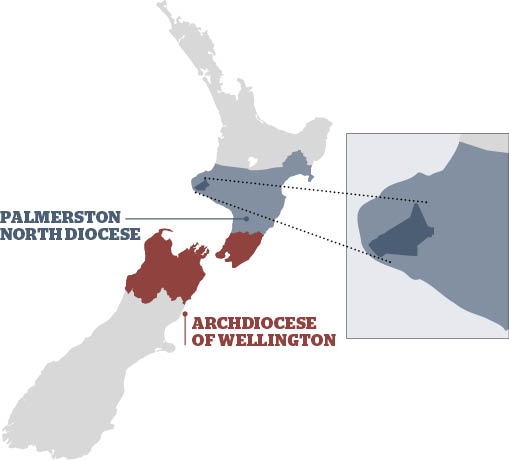
WelCom’s Hikoi of Faith this month journeys to the Immaculate Conception Parish in the eastern-central region of Taranaki. The parish area encompasses the Catholic community areas of the Immaculate Conception Church and St Joseph’s School in Stratford, St Patrick’s Church and School in Kaponga, St Joseph’s Church at Eltham and Sacred Heart Church at Whangamomona.
Stratford lies beneath the eastern slopes of Mt Taranaki, about halfway between New Plymouth and Hawera. Eltham is 11km south of Stratford and Kaponga is 13km west of Eltham. Whangamomona is east of Stratford on the Forgotten World Highway, SH43. SH 3 runs through Eltham and Stratford.
These rural towns serve the surrounding (mainly dairy) farming areas and light industry. Fonterra and Riverlands Freezing Works have sites at Eltham and the first rotational cowshed was invented at Eltham in the late 1960s. Chinese businessman Chew Chong exported the country’s first butter from Eltham to England in 1884. He also built the first dairy factory in 1887. Kapong a was settled in 1882 and has strong Swiss connections with some of the first settlers in the area being Swiss. It is known as the ‘Gateway to Dawson’s Falls’ on Mt Taranaki.
The Māori name for Stratford is Whakaahurangi, meaning to ‘look to the sky’. In Stratford, 67 streets are named after Shakespearian characters from 27 of his plays. Today New Zealand’s only glockenspiel clock tower plays the balcony scene from Romeo and Juliet three times a day. Stratford is the gateway to two National Parks – Egmont National Park to the west, and Whanganui National Park to the east.
Brief history
1880: Marist Priest, Fr Grogan travels regularly from Hawera to Stratford to inaugurate Catholic Services. Stratford part of New Plymouth Parish.
1884: First Stratford Catholic Church built, St Mary’s. Parish Priest, Fr Chastanyan.
1891: First Mass in Kaponga district held in the Fitzgerald home by Fr Mulvahill, parish priest of Hawera, Patea, Manaia, Eltham, Kaponga and Opunake.
1894: St Mary’s Church Stratford moved across road, on skids by team of bullocks, to become the school. Pupils taught by lay teachers. New church built, overseen by Fr James McKenna, re-named The Immaculate Conception.
1897: Fr McKenna invites Sisters from Our Lady of the Missions to take charge of existing Stratford Convent School. Around 30 children on school roll.
1898: October 23, in honour of Our Lady Queen of the Most Holy Rosary, Archbishop Redwood blesses first Eltham School/Church. Original role small, pupils taught by lay teachers.
1899: Stratford becomes own parish. Sisters from Our Lady of the Missions move into new two-storey convent in Stratford. First Kaponga Catholic Church built, St Patrick’s.
1900: Two-storey presbytery built in Stratford by first appointed parish priest, Fr Johnston.
1902: Eltham and Kaponga become one parish. Fr Daniel O’Shea arrives from Ireland, land bought in Kaponga, Presbytery built. Priests serving both communities reside in Kaponga. Eltham Church named Holy Rosary.
1906: Eltham Catholic Convent School opens. Fr Haire invites Sisters of the Mission (stationed in Stratford) to take charge of school. Sisters travel daily by train from Stratford; 45 children on school roll.
1907: Hon George Fowld, Minister of Education, visits Eltham Catholic Convent School. So impressed, gives Sisters free first-class passes on the train for as long as needed.
1909: Eltham Holy Rosary Church registered under new name ‒ St Joseph’s.
1911: Mission conducted by Fr Whelan, comments people of this district are not ‘sugar babies’ afraid of a little rain, as were those in other parts of New Zealand.
1912: Hibernian Australian Catholic Benefit Society established in Eltham. Amongst benefactors of Stratford Parish was late Mr Ferris, who made over to the church and school a farm of 100 acres. Still earning money today.
1914: ‘The Big Shift’ of both Church buildings in Eltham to Stanners St. Re-opened by Archbishop Rev Dr O’Shea, 31 May.
1917: Eltham becomes separate parish from Kaponga.
1919: 9 November, Sacred Heart Church of Whangamomona opens, overseen by Fr N Moore.
1922: Kaponga Catholic School, St Patrick’s opened by Archbishop Redwood. Sisters of the Mission brought in to teach; 50 pupils on school roll.
1923: July 11, new Eltham Convent School, St Joseph’s opens. Old school building moved to south side of church and becomes hall.
1939‒1948: ltham/Kaponga Holy Name Society founded by Fr Kavanagh. Society for laymen within the Church who would stand out as examples in the community. Motto ‘For God and Christ’.
1949: New Stratford Convent School, St Joseph’s, opened by Fr Butler.
1956: Eltham Catholic Women’s League established. Disbanded 1996.
1960: St Patrick’s Kaponga becomes separate parish.
1966: Churches built at Toko and Strathmore overseen by Fr Jeremiah McGrath.
1973: 29 July, current Immaculate Conception Church, Stratford, opened and blessed by Cardinal McKeefry.
1976: Toko Church sold to NZ Fire Service.
1978: 18 March, newly built St Patrick’s Church, Kaponga, opened and dedicated by Cardinal Delargey. Sacred Heart of Whangamomona becomes part of Stratford Parish.
1980: Parishes previously part of the Wellington Diocese now part of the newly formed Palmerston North Diocese.
1986: Stratford Parish/St Joseph’s School Hall (original 1884 church) destroyed by fire.
1987: St Vincent de Paul Stratford Conference founded.
1988: New Stratford Parish Centre. Parish Priest, Fr Walter Cook.
1997: New foyer and bell tower added to the present Immaculate Conception Church, Stratford, overseen by Fr David Bell.
2003: Closure of St Joseph’s Convent School, Eltham.
2007: Amalgamation of Immaculate Conception Parish Stratford, St Joseph’s Parish Eltham and St Patrick’s Parish Kaponga.
Taranaki Catholic Central Region
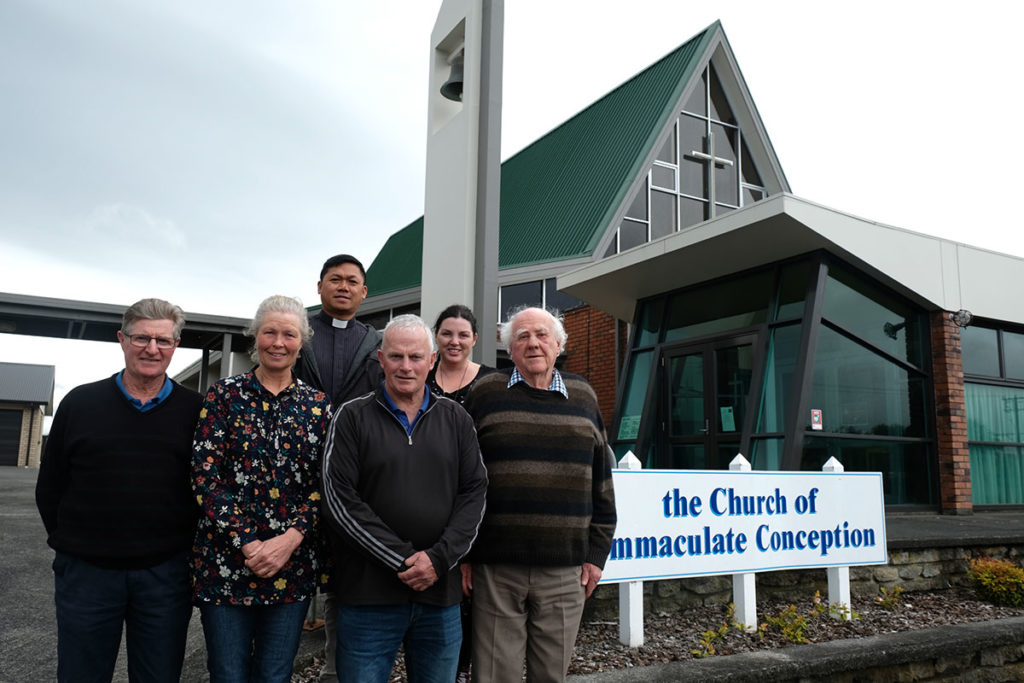
Tom Gibson
From the historical notes on this page, the reader will see this central area has a deep Catholic history. For one hundred and thirty years the region has been led by the clergy. This is our history. Going back four generations our pioneers came out seeking two important things, an education for their children and a church where they could worship their God. For our forebears, Sunday was the day of rest and this was universal. Times though are a changing.
It is appropriate to look to the future to see where the Catholic Church in Central Taranaki is headed. In 2018 we were without a resident priest. The district was obliged to hunt around to find available priests to celebrate our Sunday Masses. This shifted the ownership of our spirituality from the Palmerston North Diocese to the local parishes. We searched and found priests in retirement homes, on vacation and others looking for a break into this unusual area of Taranaki where the Mountain holds its own spiritual dominance to rural-based people. The three parishes, which had always had good relationships now worked harder in a desperate way to achieve what they did, bringing parishes closer than ever before.
Without a priest, there cannot be a Mass. There is a serious dearth of priests in the Wellington and Palmerston North dioceses and insufficient seminarians to give us hope in the short-term. Our region accepts that Liturgies will become the norm in too short a while and all three sub-parishes Stratford, Eltham and Kaponga are preparing for this. Meanwhile, we celebrate in the appointment of a young, pastoral-minded priest, Fr Adonis (Dondon) Rancho, our new parish priest, who arrived in February this year and has elevated our flagging spirits, confirming the actions we were forced to take last year were the correct ones.
When I was attending Mass at St Mary of the Angels in Wellington late last year, the parish priest there learned I was from Stratford. The priest stated that their elderly resident priest, Fr Brian Wysocki had filled in at Stratford a short time before and was impressed how prepared the region was for a new priest-less situation.
Like parishes throughout the country, we are concerned with the falling Mass attendance. We see St Joseph’s School in Stratford with an overstretched roll because of parents’ enthusiasm to have their children educated in a Catholic school, while in Kaponga parents are grateful for the attention their children receive at a school with a small roll that reflects the population of small dairying districts.
We accept who we are. We acknowledge the massive problems the Church is having with the shortage of priests. We know our young priest is too precious to be left in this backwater, because parishes will no longer be able to exist in their present forms. We ensure the faith remains strong and Father becomes available to say Mass and administer the sacraments. Our weekend Masses are at 6pm Saturday, Eltham; 8.45am Sunday, Kaponga; and 10.15am Sunday, Stratford.
This is the 21st century and the Holy Father may need to address the source of vocations.
Tom Gibson, a retired dairy farmer, is a parishioner at the Immaculate Conception Parish, Stratford, who farmed for many years in Kaponga, and is a contributing writer for WelCom.
St Joseph’s School
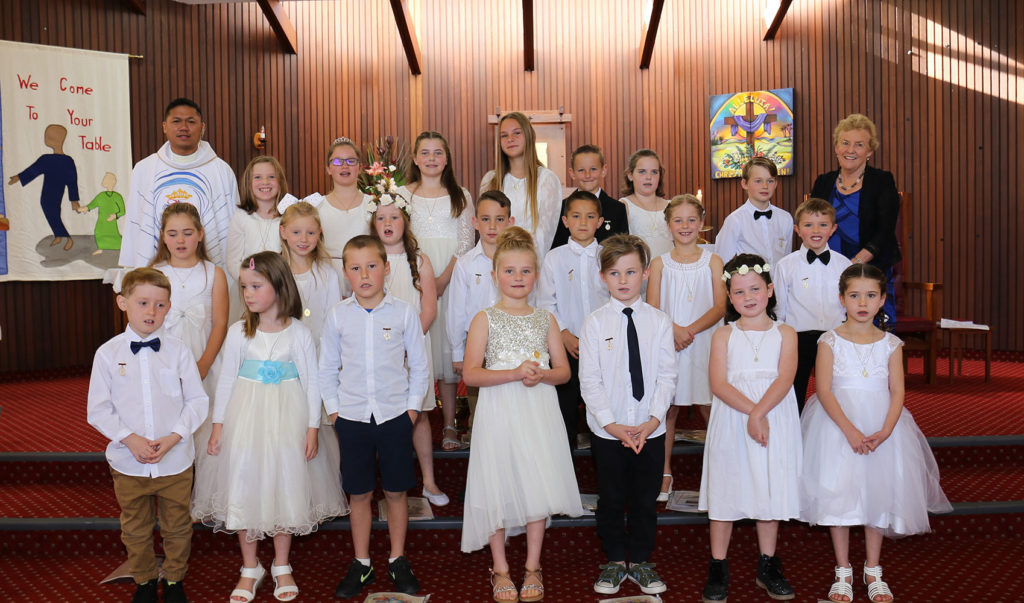
Photo: Supplied
Bernadette Radich, DRS
The Sisters of Our Lady of the Missions founded St Joseph’s School, Stratford, in 1897. Their values remain with us ‒ Contemplation: praying every day; Communion: sharing with each other; Mission: caring for those less fortunate.
The first three teachers, Mother Margaret Mary (New Plymouth), Sr Mary St Leonce (Nelson) and Sr Mary St Clement (Christchurch) took a train from New Plymouth to Stratford on 23 January 1897. At the end of their two-hour journey (today 30 minutes by car) no-one was there to meet them. They were expected following week! School began on 30 January, with 30 students, mostly of Polish, Swiss or Irish descent. In 1898 a new two-storey convent was built for the Sisters on Miranda St. It was demolished in 1978 and replaced with a new convent, which is now backpacker accommodation.
The last Religious Sister principal was in 1985 and there was one remaining teaching sister from 1991‒1993. Nineteen religious sisters have been educated at St Joseph’s Stratford.
The early pioneering families provided for and built the school, parish centre and church. Many of those same families still have great grandchildren attending St Joseph’s. Today, the school has 250 year 0‒8 students, 10 classrooms, and 20 staff and support staff.
The Parish of The Immaculate Conception Church is supportive and closely connected with St Joseph’s. There is a parish and school Family Sunday Mass each term and buddy classes at weekday Mass once a term. Sacramental programmes include Baptism, Reconciliation, and Holy Communion. On leaving the school, every Year 8 leaver is presented with a wooden cross.
St Joseph’s has a strong Board of Trustees and PTA, and our building and refurbishment programme is due to be completed this year.
The School encourages service: fundraising for Mission Day; Caritas, Young Vinnies, and World Vision; supporting the Food Bank; sponsoring a World Vision Child; student leadership; Kapa Haka; community activities; singing to elderly and visiting rest-homes; altar servers; celebrating St Joseph’s Feast Day, Grandparents’ Day, re-enacting Holy Week and more.
Connections to the Parish
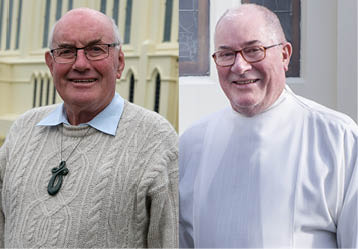
Mons Brian Walsh, Vicar General for the Diocese of Palmerton North and local administrator, was born and bred in Stratford. He grew up on a farm just out of Stratford where he attended Bridge Road primary school before going to Francis Douglas Memorial College in New Plymouth. Mons Walsh says he was brought up in a strong Catholic family environment with two brothers and one sister and has very happy memories of growing up in the area. ‘There was always a strong sense of community for us in a small farming town and always plenty to do.’ Mons Brian visits family members in Stratford regularly.
Mons David Bell, now retired and living in Palmerston North, served in Stratford as parish priest in from 2012 to 2017 and as a priest for a term in the mid-1990s. He says it’s a lively faith ‘with a strong Catholic bearing, backed up by active parishioners and the schools going very well. This has shown when the parish hasn’t had priest and the people have been well prepared to run things. For example, Barbara Kruiger ran funeral services and was strongly involved in RCIA. People are well-trained pastorally and when there wasn’t a priest in residency last year, people were able to carry the parish very well. Similarly, Kaponga and Eltham have people who have been able to step up and lead. Some of the early training we did in the diocese for leadership has paid off and that is evidenced in this parish. I had great confidence in people rising to the occasion when they were needed.’
The Whangamomona Catholic Community are holding a Centennial and Final Thanksgiving Mass at Sacred Heart Church, Ohura Rd, Whangamomona, on Saturday 9 November, 2019. All are welcome at 11am to celebrate 100 years as a Catholic Faith Community. There will be a pot-luck lunch after Mass.
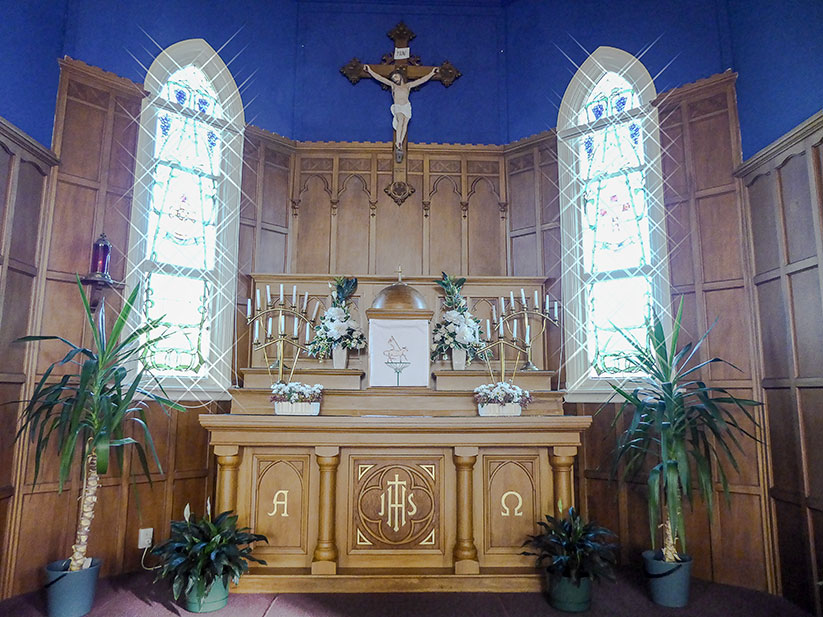
Fr Ainsworth was Eltham Parish Priest around 1911. He was an artistic man who encouraged his parishioners to appreciate beautiful surroundings. His influence is clearly seen in the embellishments in the Sanctuary of St Patrick’s Church, Eltham.
Photo: Vicki Zieltjes
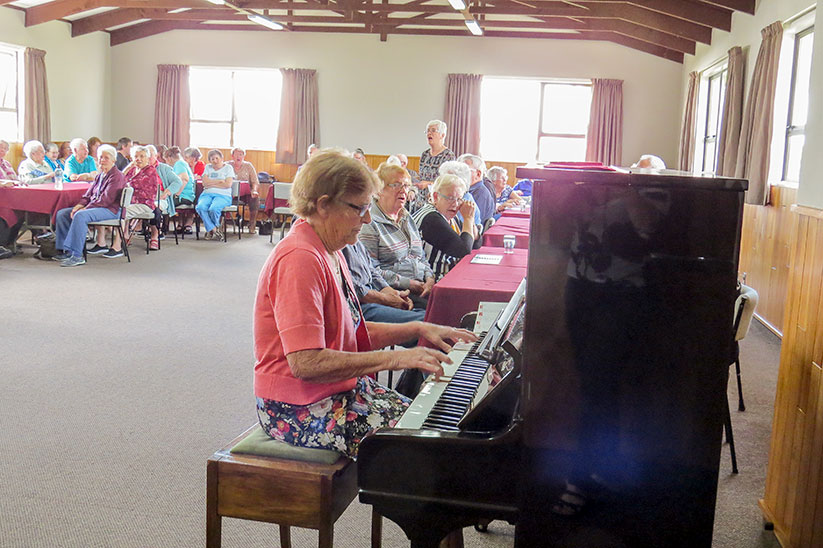
Senior Citizens Afternoon Tea
The Senior Citizens Afternoon Tea is an initiative that started in January 2007 and is run from the Parish Leadership Team. It is a monthly community event with support from the Stratford St Vincent de Paul Team and the Stratford Lions. There is also entertainment from many different groups and individuals in the district, including St Joseph’s Stratford school-children.
The Afternoon Tea started off hosting 16 people, now averages 80 to 90 people. At the annual Senior Citizens Christmas Party, it can host up to 125 people.
Afternoon Tea is held on the third Friday of the month, at the Stratford Parish Centre.
St Patrick’s School, Kaponga
Rose Kelbrick, Principal
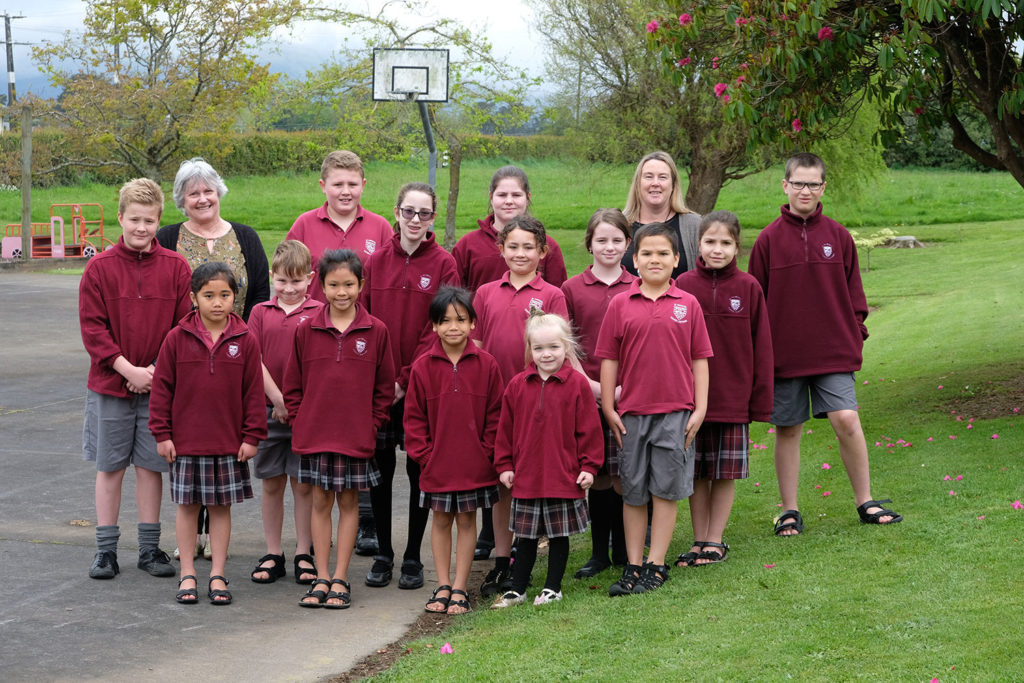
On a fine day with the majestic Mount Taranaki standing proudly and appearing to be at the end of the playing fields, you do feel as if you are visiting a special place. St Patrick’s School, Kaponga, is a small rural school, catering for students in years 0-8, located in a farming community, with a broad radius of about 10km, on the southern side of Mount Taranaki.
The school started in 1921 with lessons held in the church. It moved into its own building in February 1922. It has a long history of fostering students’ joy for living and learning in a community centred on Christ. There is considerable excitement in both the school and parish as the year of the school centennial nears. A number of priests and religious sisters attended the school as children, notably from the Crowley and Kissick families. Ex-All Black Kieran Crowley also went to St Patrick’s School.
Recent ERO and Catholic Review visits have acknowledged the high levels of achievement attained by pupils at the school. Both reports have highlighted effective practices in the areas of teaching, assessment and learning. They have recognised the positive atmosphere and family-like dynamic.
St Patrick’s School offers a broad curriculum and a range of opportunities, to extend learning, outside of the classroom. The school often visits local areas of interest and undertakes community service. Individual talents and strengths are developed.
Each week the school attends Mass at the St Patrick’s Church.
The children take leadership in various ministries. They sing beautifully, and confidently share readings and prayers in front of the congregation. The school is very fortunate to be well supported by its community and parish. The children are nurtured not only by the teachers and older students at the school but by an extended community with a vested interest in their well-being.
St Patrick’s School, Kaponga, is often referred to as a ‘hidden gem.’ It may be a small school but it has a big impact on those who visit.